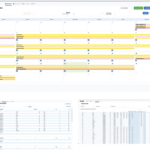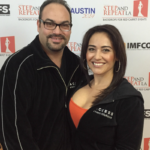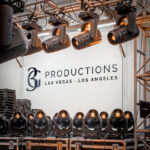One of the great joys of writing features about the professional lighting industry is getting to talk to people who, even after decades in the business, are still very enthusiastic and excited about their work. Mark Ravenhill is one of those. At 44 he is the president of the U.S. operations of German Light Products, which is celebrating its 20th anniversary. He speaks with the fervor of someone three weeks into a dream job, though he began his career in the light brigade at age 16, fresh out of the British equivalent of high school. “It’s all I’ve ever done,” the Southampton, England native explained.
The Disco Era
 Like most companies, GLP had humble beginnings. Founder Udo Künzler had been working as an electronics technician for the multinational engineering conglomerate Siemens in southwestern Germany’s Karlsbad-Karlsruhe region. He became fascinated by the work of his uncle Hartmut Braun, whose B&K Showelectronic was a major supplier to the nightclub market, and helped him set up discotheques. Eventually, Künzler became an employee of B&K and soon the head of the firm’s technical department. He modified fixtures to fit specific purposes, including early lighting pieces from Taiwan and China, and installed lighting at high-profile nightclubs. Disco was in full bloom, dominated by scanner, helicopter and flower effects.
Like most companies, GLP had humble beginnings. Founder Udo Künzler had been working as an electronics technician for the multinational engineering conglomerate Siemens in southwestern Germany’s Karlsbad-Karlsruhe region. He became fascinated by the work of his uncle Hartmut Braun, whose B&K Showelectronic was a major supplier to the nightclub market, and helped him set up discotheques. Eventually, Künzler became an employee of B&K and soon the head of the firm’s technical department. He modified fixtures to fit specific purposes, including early lighting pieces from Taiwan and China, and installed lighting at high-profile nightclubs. Disco was in full bloom, dominated by scanner, helicopter and flower effects.
Scanners particularly intrigued Künzler. In 1993, he came up with the concept for the revolutionary Patend Light, a hybrid that offered a fast scanner, a moving head and 360° beam rotation in pan and tilt mode. Housing a 575W and later a 1200W discharge lamp on an ultra-fast Roto Head, the full-featured Patend delivered smooth slow movements and incredibly fast rotations. The chassis of the original product was aluminum, with the scaled down Mini in a plastic housing. So excited was he by his invention that Künzler started a dedicated and specialized lighting company to produce it. German Light Products began in a small workshop in the B&K warehouse with two technicians. Because the Patend was complex and would take time to develop, the company first issued the simpler and more conventional Startec 2000 scanner in two versions, the 575HMI and the 250W halogen. It met with great acclaim at the Frankfurt Musikmesse in 1994 (before Prolight+Sound had broken off as an independent show), and GLP was on its way. Strong sales to discotheques and small rental companies ensued, with GLP handling all production and design in Germany.
By 1996, the Patend Light 575 was ready for its close-up at the PLASA Show in London. The product caused such excitement at the show that one well-known lighting company’s R&D director wanted to buy GLP on the spot — and might have, had not intellectual property issues interfered. Despite the emergence of other moving yoke products on the market, the 575, 1200 and Mini Patends became extremely popular and today represent icons of the period.
Other fixtures followed, most notably the Max, the Mighty Scan and the Pocket Scan 100W halogen with laser diode, which sold extensively in the U.S., with major wholesaler American DJ handling distribution. The Mini Startec II extended that family, and GLP also produced its own dedicated DMX controllers (such as the Show Designer SD1 and SD2 and the Startec 2000 controller). Other popular catalogue items included the Joy 150 and 300 in 2000, the Ypoc 250W moving head spot and wash in 2002 (followed by 575 and 700 versions) and, in 2004, the Junior Scan.
In 2006, GLP took an odd detour, expanding its R&D work into the area of football goal line technology via the start-up vehicle, Cairos Technologies. GLP was folded into Cairos while their R&D team worked feverishly on developing a new technological approach to spotting whether a ball had crossed the goal line. The target was the 2006 Soccer World Championships. GLP bought back its independence in 2010.
First impressions
Paradoxically, working within Cairos allowed GLP itself to expand. It helped them kick start the impression LED program and recruit Kasper Gissel from Martin Professional in October 2007 to lead the new adventure. Gissel’s network of contacts immediately reaped dividends. He created a completely new structure, bringing aboard some of the biggest rental companies and putting GLP in touch with lighting directors the world over. Their input and need for a product that was small, easy, powerful and lightweight inspired GLP to sire the impression 90, the industry’s first professional moving-head LED wash light that ticked all of the boxes—the right output, the right size, the right price, the right weight, the right performance parameters. It offered an even beam, superior whites and smooth dimming, and was flicker-free for TV applications. As the impression 90 was gaining industry acceptance and garnering honors, GLP began concentrating its R&D entirely on LEDs.
Soon, lighting directors and rental companies were adopting the new product en masse. High-profile endorsements stacked up quickly. The whole world was watching, literally, when in autumn of 2009, the globally telecast United Nations Climate Change Conference in Copenhagen featured more than 1,000 impressions lighting two big halls entirely in white for their energy saving levels. After some 200 impression pieces were used on the popular ZDF TV show Wetten Daß on Mallorca, off the Mediterranean coast of Spain, more rental companies began lining up. In Europe, major hire shops, such as Procon (now part of PRG) and Glenn Roggeman’s AED Rent came aboard. And after leading LDs such as Jerry Appelt and Ollie Olma adopted it, requests snowballed.
 The initial impression 90 was followed by the popular Volkslicht (“people’s light”) series, which was more commercially priced with no compromise on features. Over time, the company continued making better impressions. For example, the 120RZ Zoom used Lumileds’ Rebel LEDs, replacing the K2 used on the original impression 90. This smaller lamp enabled 120 sources to fit in the same space as the previous 90 K2s, increasing output and adding zoom capability.
The initial impression 90 was followed by the popular Volkslicht (“people’s light”) series, which was more commercially priced with no compromise on features. Over time, the company continued making better impressions. For example, the 120RZ Zoom used Lumileds’ Rebel LEDs, replacing the K2 used on the original impression 90. This smaller lamp enabled 120 sources to fit in the same space as the previous 90 K2s, increasing output and adding zoom capability.
A U.S. Presence
By 2009, GLP realized it needed representation in the New World. Enter Mark Ravenhill. A colleague of Gissel’s at Martin Pro whose lighting designs had won many accolades in his 20+ years in the industry, Ravenhill was eager to head west with his family. “When I first came over from Europe to set up GLP’s American operation,” he recalls, “it was either going to be New York or L.A., and L.A. won, partly because that’s what my family wanted. We first had a small facility in Torrance (about 20 miles southwest of downtown Los Angeles), then moved to Sun Valley (about 15 miles northwest of Los Angeles). It’s a great location, because so many manufacturers and rental companies are only a stone’s throw away, plus there are a lot of film locations and the Burbank studios nearby.” He too brought with him a stable of contacts and wasted no time creating a talented sales team to serve the rental market in the States.
Ravenhill’s philosophy? “What we really try to do is to excel in our customer support before, during and after the sale. We are small enough as a company to be able to react quickly and not get ourselves tied up by procedures that get in the way of us taking care of a customer in the best way possible. We absolutely refuse to have unnecessary procedures that would hinder our operations. We pride ourselves on being fast to react and doing the right thing.”
 It must be working. “We go through a dealer network and some of the main rental companies,” Ravenhill explains.” We are strong in the concert touring market; we do a good amount of work in the house-of-worship market, more and more in theater, auto shows and corporate events, and quite a bit on television. Usher has a couple of hundred of our new X4S fixtures on his tour (see “Production Profile,” this issue, page 32). Lenny Kravitz has quite a system out. There’s Garth Brooks, Beck, Cher, Broken Bells, Guns N’ Roses, Alice in Chains, Cage the Elephant, Bastille, Foreigner, Tim McGraw, Fleetwood Mac, Billy Joel, Widespread Panic…the list goes on and on. On TV, we’ve worked with Saturday Night Live, The Tonight Show Starring Jimmy Fallon, America’s Got Talent and Rising Star. In November 2014, GLP’s products lit the huge 25th Anniversary ‘Fall of the Wall’ Celebration at the famed Brandenburg Gate in Berlin.”
It must be working. “We go through a dealer network and some of the main rental companies,” Ravenhill explains.” We are strong in the concert touring market; we do a good amount of work in the house-of-worship market, more and more in theater, auto shows and corporate events, and quite a bit on television. Usher has a couple of hundred of our new X4S fixtures on his tour (see “Production Profile,” this issue, page 32). Lenny Kravitz has quite a system out. There’s Garth Brooks, Beck, Cher, Broken Bells, Guns N’ Roses, Alice in Chains, Cage the Elephant, Bastille, Foreigner, Tim McGraw, Fleetwood Mac, Billy Joel, Widespread Panic…the list goes on and on. On TV, we’ve worked with Saturday Night Live, The Tonight Show Starring Jimmy Fallon, America’s Got Talent and Rising Star. In November 2014, GLP’s products lit the huge 25th Anniversary ‘Fall of the Wall’ Celebration at the famed Brandenburg Gate in Berlin.”
In 2010, the impression Spot One became the industry’s first pro LED spot fixture to be both high-output and RGB, followed by the impression Wash One, its Fresnel-based sibling. More recently, GLP unveiled its X4 platform to supplant the impression 90. It includes the moving heads X4 (19 quad color 15W RGBW LEDs), X4S (7 15W RGBW LEDs), and X4 XL (55 quad color 15W RGBW LEDs), plus the batten-type fixtures including the X4 Bar 10 and X4 Bar 20. All feature stellar optics, wide color spectrum, broad zoom range and high output.
In addition to its innovative products, the company offers free intensive training at its Sun Valley location every other month that anyone is welcome to attend. “We’re all about sharing the knowledge,” says Ravenhill. “The more knowledge we can get out there, the easier everyone’s job becomes.”

As the GLP US president sees it, it’s a good time to be in the professional lighting industry. “The economy seems to be strengthening, unemployment is down, the key indicators are generally looking good. This is stimulating growth in the entertainment sectors. More casinos are being built in Las Vegas and the northeastern part of the country and a huge number of musical artists are going out on tour again. And of course, they all need lighting. The advances in LEDs have been fantastic. We’re getting brighter output from a smaller footprint. As a whole, I think the industry is very alive and doing well. As for GLP US, we’ve been here for five years and we’re absolutely staying. We’ve got a great product line that’s being accepted well by the customers. We have many things planned and intend to be the first to market with the next generations of technology. We’ll keep making the tools designers ask for. We spend a lot of time communicating with the market and are always open to ideas people have and want to see turned into reality.”
He concludes, “At the end of the day, it’s all about the show. You do whatever it takes. That’s the mentality of everybody whose heart is in this industry, and everybody at GLP US.”
For more information, please visit glp.de and germanlightproducts.com


